|
|
|
Sort Order |
|
|
|
Items / Page
|
|
|
|
|
|
|
| Srl | Item |
| 1 |
ID:
138128


|
|
|
|
|
| Summary/Abstract |
In November 2012, soon after the conclusion of the 18th National Congress of the Communist Party of China (CPC), President Xi Jinping put forward for the first time the idea of the ‘Chinese Dream’. In March 2013, Xi further elaborated on this concept at the closing ceremony of the First Session of the 12th National People’s Congress. Xi’s concept of the Chinese Dream involves better education, more stable employment, higher incomes, a greater degree of social security, better medical and health care, improved housing conditions, a better environment, satisfactory jobs and better lives for the Chinese people. In foreign affairs, Xi emphasised that the Chinese Dream stands for peace, development, cooperation and mutual benefit for all. These are all unexceptional sentiments that could have been expressed by any national leader and thus few would disagree with Xi’s laudable thoughts. But what is the position on the ground and how is China faring under Xi Jinping’s rule in the achievement of these goals?
|
|
|
|
|
|
|
|
|
|
|
|
|
|
|
|
| 2 |
ID:
138127
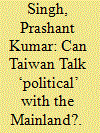

|
|
|
|
|
| Summary/Abstract |
An investigation into the prospects for including political talks in the cross-strait dialogue enables a better assessment of cross-strait relations. China’s push for political talks and Taiwan’s resistance to them imply that their political positions on the fundamental issues of sovereignty and ‘living space’ for Taiwan remain unchanged. Considering Taiwan’s complex domestic political scenario, which is largely against unification with Mainland China, the likelihood of Taiwan agreeing to political talks for unification is remote. While the ruling Kuomintang extends qualified support for political talks, the opposition parties reject them outright. In addition, deepening popular anxiety against closer cooperation with Mainland China further constrains prospects for political talks.
|
|
|
|
|
|
|
|
|
|
|
|
|
|
|
|
| 3 |
ID:
138131
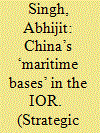

|
|
|
|
|
| Summary/Abstract |
After a successful visit by Prime Minister Narendra Modi to Colombo in March, Indian policy elite are hopeful that the new Sri Lankan government will roll-back some of the geopolitical concessions made by the Rajapaksa regime to Beijing, thereby restoring India’s primacy in its near neighbourhood. India’s policy elite are hopeful that Maithripala Sirisena, the new president, will roll back some of the geopolitical concessions made by his predecessor to Beijing, thereby restoring Indian primacy in its near neighbourhood.
New Delhi’s maritime analysts, however, remain a worried lot. Ever since a PLA-Navy (PLA-N) submarine docked twice in Colombo last year, Indian sea-power thinkers have been considering the prospect of a permanent Chinese naval presence in the Indian Ocean. Since November 2014, there have been strong rumours of a possible PLA-N base in the Indian Ocean Region (IOR). Media reports have indicated that Beijing was discussing a plan for multiple basing facilities in the Indian Ocean. An alarmed New Delhi even revived an old proposal for an Indian Ocean Zone of Peace—all in the hope that it would dissuade China from appropriating valuable space in its ‘strategic backyard’.
|
|
|
|
|
|
|
|
|
|
|
|
|
|
|
|
| 4 |
ID:
138132
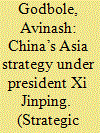

|
|
|
|
|
| Summary/Abstract |
China has reoriented its foreign policy strategy since Xi Jinping became president. This could significantly recast China’s relations with Asian countries. The process that began with Xi Jinping’s coming to power in 2012–2013 reached, in a sense, a definitive moment, with the Central Conference on Work Relating to Foreign Affairs held in Beijing in November 2014. From an earlier strategy of lying low to the present-day outlook of leading from the front and from a diplomatic strategy centred on great powers to one focusing on neighbourhood, China has come a long way within a relatively short space of time.
|
|
|
|
|
|
|
|
|
|
|
|
|
|
|
|
| 5 |
ID:
138125
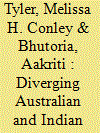

|
|
|
|
|
| Summary/Abstract |
Australia has a vital interest in preventing the Indian Ocean Region from becoming an arena of great power rivalry, including between India and China. The 2013 Defence White Paper clearly delineates the Indo-Pacific as an area of supreme importance to Australia. Developing a close strategic partnership with India is an important part of this strategy. However, there is a fundamental disconnect between Australian and Indian perceptions of the Indo-Pacific: on balance, Australia prefers to avoid being part of any formulation that could be seen as attempting to contain China and prefers an inclusive framework; by contrast, mainstream thinking in India has opposed the inclusion of China and is anxious about the growing visibility of China in the Indian Ocean Region. This means that Australia finds itself stuck in a cleft stick in managing China’s and India’s different views of the Indo-Pacific. This divergence in views leads to the potential for misunderstanding and conflict between Australian and Indian views.
|
|
|
|
|
|
|
|
|
|
|
|
|
|
|
|
| 6 |
ID:
138130
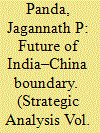

|
|
|
|
|
| Summary/Abstract |
Will India and China resolve their boundary dispute during the tenure of Narendra Modi and Xi Jinping? The strategic communities in both countries are optimistic, particularly after the high tension prevailing along the border during President Xi Jinping’s tour of India in September 2014. Both Prime Minister Modi and President Xi are seen as decisive leaders.1 Both are expected to hold power in their respective countries for a few years to come. Personalities and personas matter greatly for scoring political brownie points. The boundary dispute, quintessentially, is political in nature. The 2005 Agreement on the ‘Political Parameters and Guiding Principles for the Settlement of the India–China Boundary Question’ acknowledged as much: the ‘two sides are seeking a political settlement of the boundary question’.2 In future India–China boundary negotiations, will the two leaders go for territorial exchange or will they remain content with the status quo, and simply define the Line of Actual Control (LAC)?
|
|
|
|
|
|
|
|
|
|
|
|
|
|
|
|
| 7 |
ID:
138126
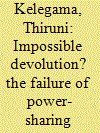

|
|
|
|
|
| Summary/Abstract |
The concept of a ‘primordial homeland’ has been at the centre of Sri Lanka’s armed struggle, in which both Sinhalese and Tamil nationalisms have used claims of ancient and ethnically determined territories to justify their right to self-determination, territorial sovereignty and armed struggle. Through an analysis of historical power-sharing arrangements and the subsequent failures, this article will examine why there has been much difficulty in adapting power-sharing arrangements to the rigidity of the hegemonic ethnic order of Sri Lanka and how this, in turn, has had detrimental consequences for democratic stability and peace making. While recognising the role played by various international actors in pushing for power sharing in Sri Lanka, the article concludes with an analysis of India’s role in this debate, while analysing how devolution has become an important factor in shaping India’s foreign policy towards Sri Lanka.
|
|
|
|
|
|
|
|
|
|
|
|
|
|
|
|
| 8 |
ID:
138129


|
|
|
|
|
| Summary/Abstract |
Since assuming the throne on January 23, 2015 following the death of King Abdullah, Saudi Arabia’s new monarch, King Salman, seems to have set about the task of shaking up the ultraconservative kingdom. The punishment or pardoning of Raef Badawi became the litmus test of the new Saudi monarch’s reign as the blogger’s sentence coincided with the last days of the ailing King Abdullah and King Salman was compelled to face his personal past as promoter of Islamic fundamentalism abroad. As the new court takes modest steps to burnish the regime’s human rights record, postponing Badawi’s second round of 50 lashes and releasing his colleague Souad al-Shammari (arrested in October 2014), the offshoots spawned by Wahhabi extremist ideology could still push the desert kingdom over the brink. The new king’s unenviable task is to lead the country into the 21st century while preserving the monarchy, retaining the Wahhabi creed from which it derives legitimacy while somehow containing its troublesome fallout. As borders crumble around Saudi Arabia, this is clearly a tall order.
|
|
|
|
|
|
|
|
|
|
|
|
|
|
|
|
| 9 |
ID:
138133


|
|
|
|
|
| Summary/Abstract |
A visa is issued to facilitate an individual’s travel to another country in a regulated way. There are agreements between some countries on a no-visa regime; however, most countries do follow some sort of visa system. Typically, a visa allows a person to travel to the destination country as far as the port of entry (airport, seaport or land border crossing) and advises the immigration officer to allow the visitor to enter the country. It also stipulates the purpose of the visit, maximum duration of stay on each visit and number of entries allowed to the traveller within the validity period of the visa. Although most countries use printed visa stickers, e-visas have recently also come into vogue.
|
|
|
|
|
|
|
|
|
|
|
|
|
|
|
|
|
|
|
|
|